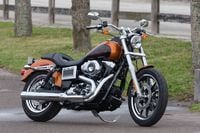The original Low Rider was an instant best seller when it appeared in 1977, sought after both for its clean, stripped-down look and its fine handling dual-shock frame. The Low Rider soon became the ride of choice for Hells Angels and other hard-riding outlaw bikers, renowned for its ability to cover long distances quickly and comfortably. A legend was born.
The Low Rider survived in The Motor Company lineup for more than 30 years, becoming predictably softer and slacker with age until it was discontinued five years ago. Now the Low Rider nameplate is back in an all-new Dyna rendition that recreates the lean, long-running original. Designed by Tony Pink and inspired by an original Low Rider plucked from the floor of the Harley-Davidson Museum, the new bike faithfully recreates key styling cues like a square battery box with reversed-out Low Rider logo, the suspended headlight floating under its polished eyebrow, and Fat Bob tanks with stacked gauges in a center console.
The latest Low Rider nails the iconic look and sets a new standard for cruiser comfort with a two-position saddle and adjustable handlebars. Fit was extremely important: The Dyna is popular with women and also overseas—particularly in Japan, Harley-Davidson says—so it had to fit riders from 5-foot-1 to 6-foot-1 and up. Leveraging "the latest ergonomic science," including computer simulation and 3-D mannequins to "generate optimal rider triangles," engineers basically reinvented dog-bone handlebar risers and a removable saddle bolster that allow the handlebars to roll 2.4 inches fore and aft and the seating position to be adjusted 1.5 inches back and forth.
Although The Motor Company might slightly oversell the innovation here, it's baffling that more motorcycles don't incorporate such easy, elegant ergonomic adjustment. The result is an exceptionally comfortable cruiser, with a slouchy, 25.4-inch saddle height and an easy reach to foot controls that have been moved forward 2 inches. This increases legroom, but for longer rides we prefer the mid-mount controls on other Dynas that let you more easily engage your legs to better support your body.
Don't let the Low Rider name and cruiser styling fool you—this feels more like a relaxed standard than a factory chopper. It's funny how, as metric (and other American) cruisers get more cartoonishly oversized and exaggerated, Harley-Davidsons feel more all-around capable. Right-sized and perfectly tuned, the latest version credibly maintains the Low Rider reputation as a rider's bike. With balanced geometry and sure-footed Michelin Scorcher tires, you'll be surprised how well this bike handles. Despite totally non-adjustable Showa suspension, new "Tri-Rate" springs at both ends still manage to always deliver just the right response. Biased toward control over comfort, Harley-Davidson says, there are three spring rates that increase in stiffness through the travel for a plush ride over small bumps and superior control when you push the pace. With almost no pitching or diving under hard braking or accelerating, the Low Rider is remarkably athletic for a 666-pound (claimed) bike.
The Twin Cam 103 V-twin and Cruise Drive six-speed transmission are a well-known powertrain combination. That familiar, kicked-by-the-boot-of-God low-end acceleration that only comes from 98.8 pound-feet of torque at 3,500 rpm (claimed) will yank the handlebar from your hands if you're not careful, and the 2-into-1 pipe—another nod to the original Low Rider—sounds super. No less than three discs slow this iron horse, though braking response is soft and lacking power—a toothier pad would be an improvement—and the rear brake pedal is oddly located too. No complaints, however, about optional and almost completely transparent ABS, which we had ample opportunity to experiment with on the wet Florida back roads.
The modern Motor Company excels at repurposing its past to create new motorcycles relevant to another generation of enthusiasts. The re-popped Low Rider plays to that strength, combining classic looks with up-to-date technology—and a custom-tailored fit—to create another desirable bike that's equally attractive to patch-wearing one-percenters and the rest of us.
The Dyna platform gets ’70s-era styling and adjustable ergonomics to create a new-generation Low Rider.
Honda Fury and Sabre, Star Stryker, Triumph Thunderbird, Victory Gunner and Judge
Another modern classic from The Motor Company, ready to cruise comfortably and con-fidently for many miles.
Harley-Davidson has had some success with its Switchback light-tourer, but smaller-statured riders still clamored for something even more manageable. The Motor Company responded with this new model, basically the existing 883cc SuperLow with the 1,200cc engine and a little extra P&A; in the form of fixed saddlebags and a quick-release windscreen.
With a claimed curb weight of 572 pounds, the $11,799 SuperLow T is 124 pounds lighter than the Switchback and 207 pounds lighter than the Road King. With a 26-inch seat height, compact "mini-board" footrests, and a narrower saddle and handlebar, this bike is tailor-made for riders 5-foot-1 to 5-foot-7. The bigger Evo motor is more willing to carry highway speeds, even if it vibes a little above 75 mph. Shifting is smooth, though, brakes are enough, and a 32-click remote preload adjuster makes the rear suspension easy to tune. Harley really does build a bike for everyone.


















/cloudfront-us-east-1.images.arcpublishing.com/octane/QSTCM6AVEZA5JJBUXNIQ3DSOF4.jpg)
/cloudfront-us-east-1.images.arcpublishing.com/octane/U4I7G625B5DMLF2DVIJDFZVV6M.jpg)
/cloudfront-us-east-1.images.arcpublishing.com/octane/B6XD6LS6IVCQPIU6HXDJSM3FHY.jpg)
/cloudfront-us-east-1.images.arcpublishing.com/octane/ICL63FEDDRDTTMINYICCEYGMDA.jpg)
/cloudfront-us-east-1.images.arcpublishing.com/octane/FCGZHQXRBZFLBAPC5SDIQLVF4I.jpg)
/cloudfront-us-east-1.images.arcpublishing.com/octane/WNOB6LDOIFFHJKPSVIWDYUGOPM.jpg)

/cloudfront-us-east-1.images.arcpublishing.com/octane/X33NU3E525ECRHXLNUJN2FTRKI.jpg)
/cloudfront-us-east-1.images.arcpublishing.com/octane/6KKT5NNL2JAVBOXMZYS5ZO76YA.jpg)
/cloudfront-us-east-1.images.arcpublishing.com/octane/J5RKG5O455GMPGQRF2OG6LRT7A.jpg)
/cloudfront-us-east-1.images.arcpublishing.com/octane/GX2CIZKQVRH2TATDM26KFG2DAE.jpg)
/cloudfront-us-east-1.images.arcpublishing.com/octane/ZWIDYSAKQZHD5BHREMQILXJCGM.jpg)
/cloudfront-us-east-1.images.arcpublishing.com/octane/CYUHJZCTSJCH3MRAQEIKXK7SCQ.jpg)
/cloudfront-us-east-1.images.arcpublishing.com/octane/LKOFINY56FCXJCANJ5M7ZDQUBY.jpg)
/cloudfront-us-east-1.images.arcpublishing.com/octane/4NBPDACMWJH63JQYJVK3QRBDZI.jpg)
/cloudfront-us-east-1.images.arcpublishing.com/octane/KKHQHRR3FJGX7H2IPU6RALMWG4.jpg)

/cloudfront-us-east-1.images.arcpublishing.com/octane/5IOFS5JAE5FOXMNA23ZRAVVYUU.jpg)
/cloudfront-us-east-1.images.arcpublishing.com/octane/CGXQ3O2VVJF7PGTYR3QICTLDLM.jpg)

/cloudfront-us-east-1.images.arcpublishing.com/octane/OQVCJOABCFC5NBEF2KIGRCV3XA.jpg)
/cloudfront-us-east-1.images.arcpublishing.com/octane/OPVQ7R4EFNCLRDPSQT4FBZCS2A.jpg)
/cloudfront-us-east-1.images.arcpublishing.com/octane/YBPFZBTAS5FJJBKOWC57QGEFDM.jpg)
/cloudfront-us-east-1.images.arcpublishing.com/octane/W5DVCJVUQVHZTN2DNYLI2UYW5U.jpg)